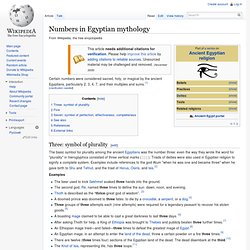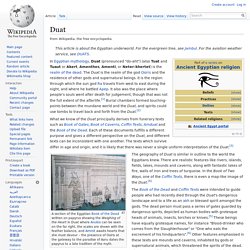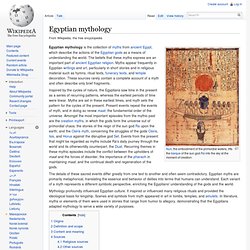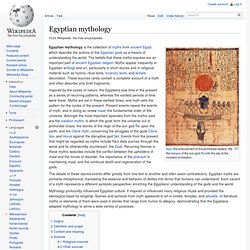

Numbers in Egyptian mythology. Certain numbers were considered sacred, holy, or magical by the ancient Egyptians, particularly 2, 3, 4, 7, and their multiples and sums.[1][clarification needed] Three: symbol of plurality[edit] Examples Five[edit] Fives are less common in Egyptian mythology.

Seven: symbol of perfection, effectiveness, completeness[edit] The number seven was apparently the Egyptian symbol of such ideas as perfection, effectiveness, and completeness. Seven thousand barrels of red beer were used to trick Sekhmet out of killing. [18]In her search for her husband’s pieces, the goddess Isis was guarded by seven scorpions. [19]A legendary famine lasted seven years. [20]The lowest amount that the Nile flooded to solve the famine was seven cubits.
See also[edit] References[edit] External links[edit] "Ancient Egypt: the Mythology"
Deitys. Duat. This article is about the Egyptian underworld.

For the evergreen tree, see Jambul. For the aviation weather service, see DUATS. In Egyptian mythology, Duat (pronounced "do-aht") (also Tuat and Tuaut or Akert, Amenthes, Amenti, or Neter-khertet) is the realm of the dead. The Duat is the realm of the god Osiris and the residence of other gods and supernatural beings. It is the region through which the sun god Ra travels from west to east during the night, and where he battled Apep. What we know of the Duat principally derives from funerary texts such as Book of Gates, Book of Caverns, Coffin Texts, Amduat and the Book of the Dead. A section of the Egyptian Book of the Dead written on papyrus showing the Weighing of the Heart in Duat where Anubis can be seen on the far right, the scales are shown with the feather balance, and Ammit awaits hearts that she must devour – the presence of Osiris at the gateway to the paradise of Aaru dates the papyrus to a late tradition of the myth.
References. Ancient Egyptian religion. Egyptian mythology is the collection of myths from ancient Egypt, which describe the actions of the Egyptian gods as a means of understanding the world.

The beliefs that these myths express are an important part of ancient Egyptian religion. Myths appear frequently in Egyptian writings and art, particularly in short stories and in religious material such as hymns, ritual texts, funerary texts, and temple decoration. These sources rarely contain a complete account of a myth and often describe only brief fragments. The details of these sacred events differ greatly from one text to another and often seem contradictory. Egyptian myths are primarily metaphorical, translating the essence and behavior of deities into terms that humans can understand. Mythology profoundly influenced Egyptian culture. Origins[edit] The development of Egyptian myth is difficult to trace. Another possible source for mythology is ritual.
Definition and scope[edit] Content and meaning[edit] Sources[edit] Egyptian mythology. Egyptian mythology is the collection of myths from ancient Egypt, which describe the actions of the Egyptian gods as a means of understanding the world.

The beliefs that these myths express are an important part of ancient Egyptian religion. Myths appear frequently in Egyptian writings and art, particularly in short stories and in religious material such as hymns, ritual texts, funerary texts, and temple decoration. These sources rarely contain a complete account of a myth and often describe only brief fragments. The details of these sacred events differ greatly from one text to another and often seem contradictory. Egyptian myths are primarily metaphorical, translating the essence and behavior of deities into terms that humans can understand. Mythology profoundly influenced Egyptian culture. Origins[edit] The development of Egyptian myth is difficult to trace. Another possible source for mythology is ritual. Definition and scope[edit] Content and meaning[edit] Sources[edit]